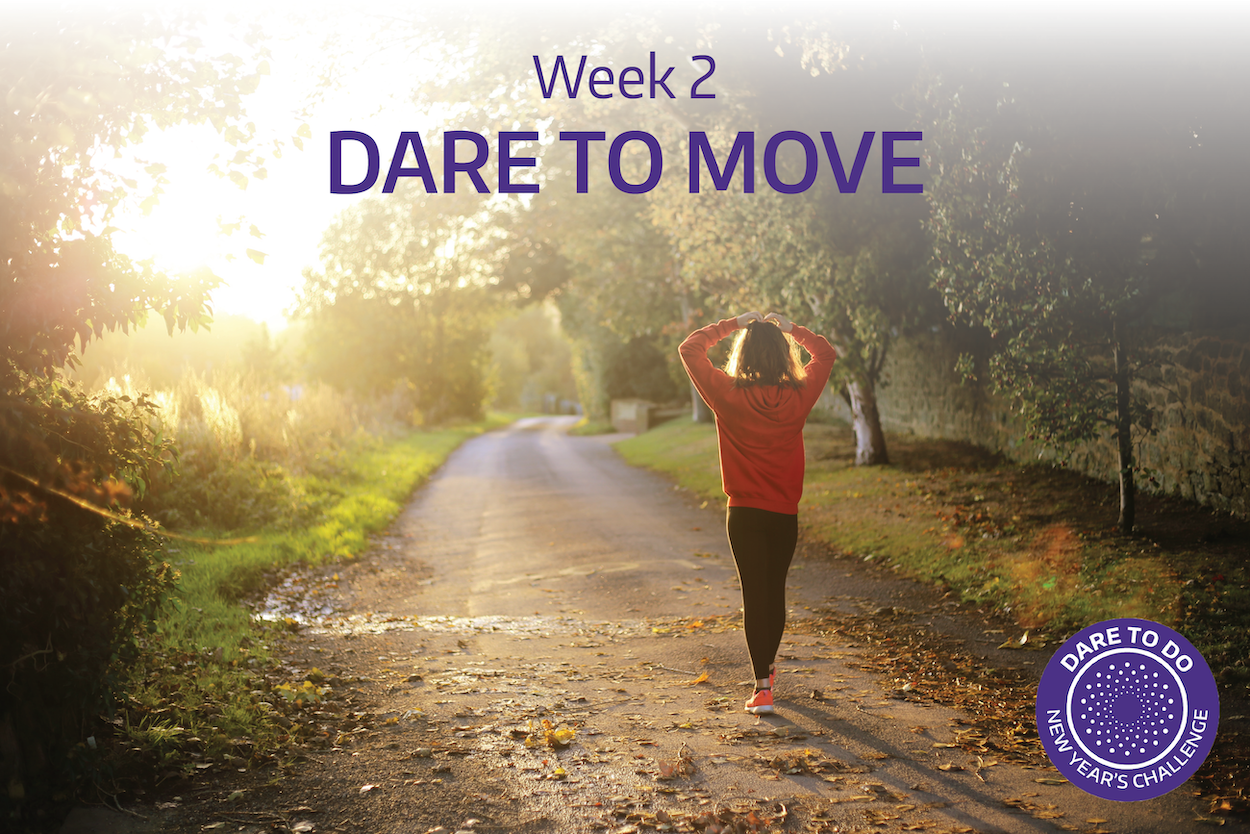
How to Create an Exercise Plan
Welcome to the second week of Dare to Do, the 8-week wellness challenge for making lasting, positive change in the New Year! This week, we’ll be encouraging you to Dare to Move—incorporating fitness and physical activity throughout your day.
It’s hard to believe that we are already halfway into January. As with any other New Year, people all across the country have made commitments to improve their health and wellbeing. As UW Recreation’s Fitness Manager, I applaud you and I want to support you by giving you some tools to write and stick to a fitness plan. But first, let’s go back to the basics…
Last year the U.S. Department of Health and Human Services published their second edition of the Physical Activity Guidelines for Americans. This comprehensive publication offers guidelines for children, adolescents, adults (including women during pregnancy and the postpartum period, as well as adults with chronic health conditions and adults with disabilities), and older adults. For the purpose of this article, I’m going to focus on the recommendations for adults.
In summary:
- Move more, sit less.
- Some physical activity is better than none and some health benefits can be attained by doing any amount of moderate-to-vigorous physical activity.
- For significant health benefits, adults should do at least:
- 150-300* minutes a week of moderate-intensity aerobic activity, OR
- 75-150 minutes a week of vigorous-intensity aerobic activity, OR
- An equivalent combination of moderate- and vigorous-intensity aerobic activity per week.
- Ideally, aerobic activity is spread throughout the week.
- *Note: additional health benefits are gained by engaging in physical activity beyond the equivalent of 300 minutes of moderate-intensity physical activity a week.
- Muscle-strengthening activities can provide additional health benefits.
- Target all major muscle groups on 2 or more days per week.
- Perform muscle-strengthening activities of moderate or greater intensity.
So there you have it—in a given week, at a minimum, you should be striving for 150 minutes of moderate-intensity aerobic activity and 2 days of muscle-strengthening activities. Now that you know the basic formula, you can start to write your own personal fitness plan. Here are some examples:
In a week, you could do…
- 30 minutes of moderate-intensity aerobic activity on 5 days and do muscle-strengthening activities the other two days.
- 50 minutes of moderate-intensity aerobic activity on 3 days, muscle-strengthening activities on 2 days, and rest the other 2 days.
- 25 minutes of vigorous-intensity aerobic activity on 3 days, muscle-strengthening activities on 2 days, and rest the other 2 days.
Examples of moderate-intensity physical activity include:
- Brisk walking
- Recreational swimming
- Bicycling slower than 10 miles per hour on level terrain
- Group fitness classes like water aerobics
- General yard work or home repair
Examples of vigorous-intensity physical activity include:
- Jogging or running
- Swimming laps
- Bicycling faster than 10 miles per hour
- Group fitness classes like kickboxing
- Heavy yard work like shoveling
More on muscle-strengthening activities:
- Includes resistance training and weight lifting (this includes body weight exercises like push-ups or rock climbing)
- Focus on the muscles of the legs, hips, back, abdomen, chest, shoulders, and arms
- Consider the following variables:
- Frequency – how often you do a muscle-strengthening activity, remember you’re aiming for 2 days per week
- Intensity – how much weight or force is used relative to how much a person is able to lift, ideally to the point at which it would be difficult to do another repetition.
- Sets/repetitions – one set of 8-12 repetitions of each exercise is effective; however, 2-3 sets may be more effective.
When the U.S. Department of Health and Human Services released these updated guidelines, they launched a campaign called Move Your Way. This campaign includes an interactive Activity Planner where you can set weekly goals and design a plan that works for you.
The Move Your Way Activity Planner even has a comprehensive list of activities that are categorized by aerobic activity (look for the heart symbol) and/or muscle-strengthening activity (look for the dumbbell symbol). It’s important to note that some activities, like high intensity interval training (HIIT), rock climbing, and pushing a lawn mower, can be classified as multicomponent physical activities (meaning it combines both aerobic and muscle-strengthening activities).
Well, what about yoga—where does that fit in? Yoga, depending on the form, can be categorized as low-intensity (gentle yoga and more meditative forms) or moderate- to vigorous-intensity (Vinyasa yoga). Depending on the intensity and the postures practiced, yoga can also be classified as a multicomponent physical activity. Nevertheless, yoga offers immense benefits, both physical and mental.
Before you launch into your new and improved fitness plan, consider the following safety recommendations:
- There are certain risks associated with physical activity, but be confident that some level of physical activity can be safe for almost everyone.
- Choose types of physical activity that are appropriate for your current fitness level and health goals.
- Increase physical activity gradually over time to meet the guidelines.
- Use appropriate gear and equipment, choose safe environments, follow rules and policies, and be sensible about when, where, and how to be active.
- Consult with a health care professional if you have chronic conditions or symptoms. Your health care professional can make recommendations about the types and amounts of physical activity that are appropriate for you.
So now that you know the basic guidelines and safety recommendations, have some examples of physical activities, and have an interactive tool to help you set goals and design a plan, you’re ready to go!
UW Recreation has partnered with the Whole U during the Dare to Do Challenge to offer UW employees 2 free visits to the IMA. Sign up to participate in Dare to Do to get access. If you utilize one or both of your passes this week, you can participate in some of our free fitness and/or mindfulness classes.
I look forward to seeing you at the IMA! Happy New Year!
Thank you to AT&T, UW Medicine, BECU, US Bank, UW Recreation, 24hr Fitness, Pure Barre, and Fremont Health Club for being Dare to Do 2019 sponsors!
 Jessica Norman is the Fitness Manager for UW Recreation. She holds multiple certifications with nationally recognized organizations including the American College of Sports Medicine and the American Council on Exercise. As a Whole U Ambassador, Jessica has led multiple movement experiences including UW’s Guinness World Record attempt for the world’s largest exercise ball class. She is passionate about encouraging others to discover a more active, healthy lifestyle for themselves.
Jessica Norman is the Fitness Manager for UW Recreation. She holds multiple certifications with nationally recognized organizations including the American College of Sports Medicine and the American Council on Exercise. As a Whole U Ambassador, Jessica has led multiple movement experiences including UW’s Guinness World Record attempt for the world’s largest exercise ball class. She is passionate about encouraging others to discover a more active, healthy lifestyle for themselves.